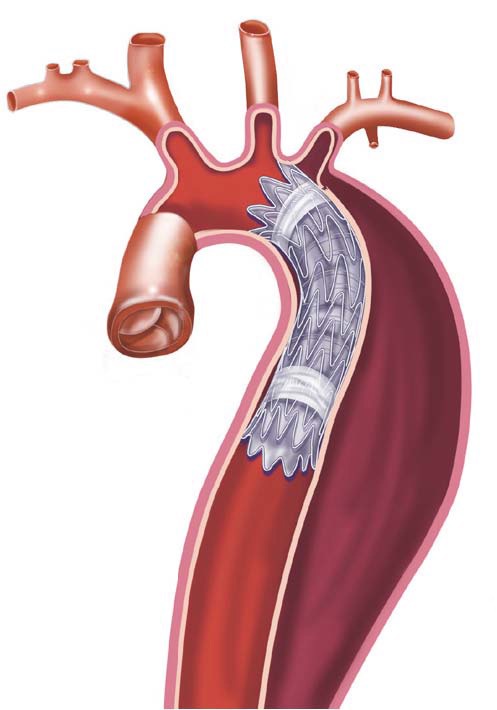 CLINICAL SIGNS:
CLINICAL SIGNS:
* in an adult (3 men for 1 woman) between 40 and 70 years old, often hypertensive (70-90%).
* severe thoracic or dorsal or posterior pain , migrating to the abdomen in 90% of cases but also the loins.
* high blood pressure in 2/3 of cases, widening of the differential, asymmetry> 2 cmHg.
* disappearance or asymmetry of peripheral pulses.
* acute aortic insufficiency possible, often moderate, to look for the auscultation ( aortic diastolic murmur ).
* sometimes painless abdominal beating mass but no contracture or abdominal defense.
* complications:
– acute ischemia of a lower limb.
– stroke, paraparesis, paraplegia (10%).
– collapse, heart failure, congestive heart failure.
– acute renal failure with oligo-anuria.
– rupture of the dissection:
– it is extremely urgent: initial syncope, thoracic or posterior transfixing pain, circulatory failure, hemopericardium, abdominal defense.
– crack in the duodenum: digestive haemorrhage that makes the diagnosis err.
DIFFERENTIAL DIAGNOSIS:
* myocardial infarction, (do not make heparin in the dissection!).
* pulmonary embolism.
* acute pericarditis.
* other chest pain.
* abdominal emergencies, renal colic.
* low back pain or acute sciatica.
ETIOLOGY:
* arterial hypertension .
* Marfan disease.
coarctation or congenital bicuspidia of the aorta.
* pregnancy.
* thoracic trauma.
ADDITIONAL TESTS:
* scope, SpO².
* ECG:
– normal, which must make evoke the diagnosis.
– or misleading : signs of ischemia-lesion, left ventricular hypertrophy, tachycardia.
* chest x-ray:
– sometimes widening of the right mediastinum if ascending aorta, left if aorta descending in 80% of cases.
transthoracic or transesophageal ultrasound .
* chest CT scan if transesophageal echography not performed.
TREATMENT:
* venous route, oxygen therapy mask.
* analgesic IV or analgesia.
* lower the systolic BP to about 120 mmHg:
– Loxen 20: 2 tablets.
– Loxen: 1 to 2.5 mg IV or Eupressyl: 25 mg IV then relay with the electric syringe.
* Lenitral : 1 mg / h IV continuous (max: 3 mg / h).
* if shock condition:
– macromolecules, Dobutrex: 10 μg / kg / min.
– anti-shock pants if abdominal aneurysm.
* if vital distress:
– intubation, assisted ventilation after sedation (Hypnovel + Fentanyl).
* Surgical treatment as soon as possible.
